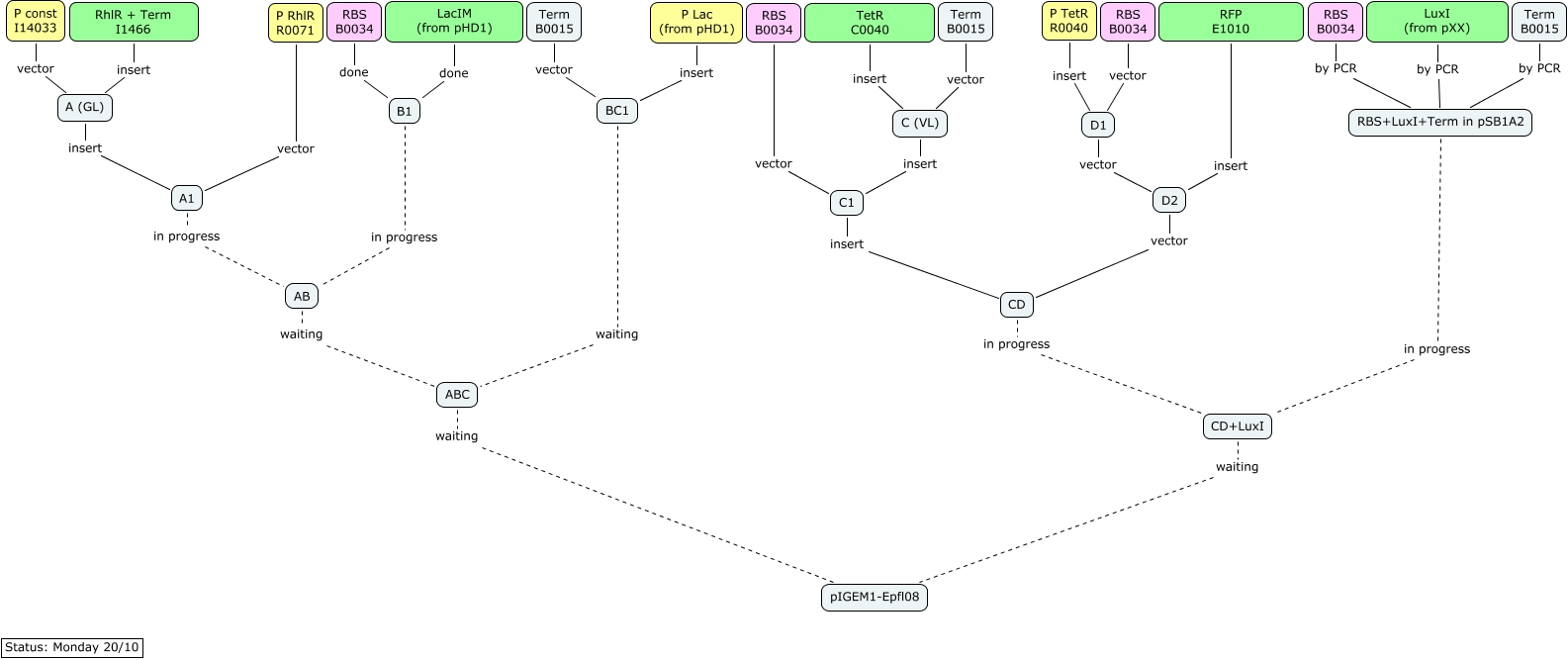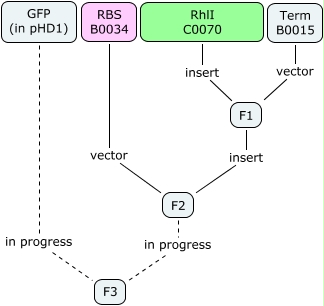Team:EPF-Lausanne/Notebook
From 2008.igem.org
| Line 281: | Line 281: | ||
* Remove devices from oven and punch flow layer holes | * Remove devices from oven and punch flow layer holes | ||
| - | == | + | ===References=== |
| - | + | 1 | |
| - | + | Anderson, J. C., Voigt, C. A., and Arkin, A. P., Environmental signal | |
| - | + | integration by a modular AND gate. Molecular Systems Biology 3 (2007). | |
| - | + | 2 | |
| - | + | Basu, S. et al., A synthetic multicellular system for programmed pattern | |
| - | + | formation. Nature 434 (7037), 1130 (2005). | |
| - | + | 3 | |
| - | + | Brenner, K., Karig, D. K., Weiss, R., and Arnold, F. H., Engineered | |
| - | + | bidirectional communication mediates a consensus in a microbial biofilm | |
| - | + | consortium. Proceedings of the National Academy of Sciences of the | |
| - | + | United States of America 104 (44), 17300 (2007). | |
| - | + | 4 | |
| - | + | Camilli, A. and Bassler, B. L., Bacterial small-molecule signaling pathways. | |
| - | + | Science 311 (5764), 1113 (2006). | |
| - | + | 5 | |
| - | + | Fuqua, C., Parsek, M. R., and Greenberg, E. P., Regulation of gene | |
| - | + | expression by cell-to-cell communication: acyl-homoserine lactone | |
| - | + | quorum sensing. Annu Rev Genet 35, 439 (2001). | |
| - | + | 6 | |
| - | + | Waters, C. M. and Bassler, B. L., Quorum sensing: cell-to-cell | |
| - | + | communication in bacteria. Annu Rev Cell Dev Biol 21, 319 (2005). | |
| - | + | 7 | |
| - | + | You, L. C., Cox, R. S., Weiss, R., and Arnold, F. H., Programmed population | |
| - | + | control by cell-cell communication and regulated killing. Nature 428 | |
| - | + | (6985), 868 (2004). | |
| - | + | ||
| - | + | ||
| - | + | ||
| - | + | ||
| - | + | ||
| - | + | ||
| - | + | ||
| - | + | ||
| - | + | ||
| - | + | ||
| - | + | ||
| - | + | ||
| - | + | ||
| - | + | ||
| - | + | ||
| - | + | ||
| - | + | ||
| - | + | ||
| - | + | ||
| - | + | ||
| - | + | ||
| - | + | ||
| - | + | ||
| - | + | ||
| - | + | ||
| - | + | ||
| - | + | ||
| - | + | ||
| - | + | ||
| - | + | ||
| - | + | ||
| - | + | ||
Revision as of 21:50, 21 October 2008
| Home | The Team | The Project | Parts | 2-step PCR | Microfluidics | Modeling | Notebook |
|---|
Contents |
Notebook
|
|
|
| ||||||||||||||||||||||||||||||||||||||||||||||||||||||||||||||||||||||||||||||||||||||||||||||||||||||||||||||||||||||||||||||||||||||||||||||||||||||||||||||||||||||||||||||||||||||||||
|---|---|---|---|---|---|---|---|---|---|---|---|---|---|---|---|---|---|---|---|---|---|---|---|---|---|---|---|---|---|---|---|---|---|---|---|---|---|---|---|---|---|---|---|---|---|---|---|---|---|---|---|---|---|---|---|---|---|---|---|---|---|---|---|---|---|---|---|---|---|---|---|---|---|---|---|---|---|---|---|---|---|---|---|---|---|---|---|---|---|---|---|---|---|---|---|---|---|---|---|---|---|---|---|---|---|---|---|---|---|---|---|---|---|---|---|---|---|---|---|---|---|---|---|---|---|---|---|---|---|---|---|---|---|---|---|---|---|---|---|---|---|---|---|---|---|---|---|---|---|---|---|---|---|---|---|---|---|---|---|---|---|---|---|---|---|---|---|---|---|---|---|---|---|---|---|---|---|---|---|---|---|---|---|---|---|---|---|---|---|
Protocols
Reference : Most of these protocols come from http://openwetware.org
SOC medium
Super Original Catabolite Repressor
Bactotryptone 20g. Bacto-yeast extract 5g. NaCl 0.5g. 1M KCl 2.5ml ddH2O to 1000 ml Total Volume 1000ml
Adjust pH to 7, with 10N NaOH. Autoclave to sterilize Add 20 ml of 1M glucose before use.
TE
10xTE for 1 liter from stock solutions 10 ml 1M Tris-HCl pH 8.0 2 ml 0.5M EDTA pH 8.0 988 ml ddH2O
→ 10xTE is 10 mM Tris-HCl and 1 mM EDTA
* For the Tris-HCl use Tris base and adjust to desired pH using HCl.
SOB: Super Original Broth
Used in growing bacteria for preparing chemically competent cells Ingredients
* 0.5% (w/v) yeast extract * 2% (w/v) tryptone * 10 mM NaCl * 2.5 mM KCl * 20 mM MgSO4
Per liter:
* 5 g yeast extract * 20 g tryptone * 0.584 g NaCl * 0.186 g KCl * 2.4 g MgSO4
!!! Adjust to pH 7.5 prior to use. This requires approximately 25 ml of 1M NaOH per liter.
CCMB80 buffer
For 1L
* 10 mM KOAc pH 7.0 (10 ml of a 1M stock/L)
* 80 mM CaCl2.2H2O (11.8 g/L)
* 20 mM MnCl2.4H2O (4.0 g/L)
* 10 mM MgCl2.6H2O (2.0 g/L)
* 10% glycerol (100 ml/L)
* adjust pH DOWN to 6.4 with 0.1N HCl if necessary
o adjusting pH up will precipitate manganese dioxide from Mn containing solutions.
* sterile filter and store at 4°C
* slight dark precipitate appears not to affect its function
Antibiotics
For each antibiotic, solutions of 5 ml have been done and stored at -20°C (09.07.08)
Transformation
We used DH5-alpha cells from Bart's lab stock. We therefore followed the InVitrogen protocol.
Electrocompetent cells preparation
From segall-lab protocol
Target DNA Protocol
Materials:
5’Comp Cy5 primer
- 5’Cy5-GTC ATA CCG CCG GA
- order from IDT at 1umole, HPLC purified
- suspend to 500uM
Library primers:
- See spreadsheet for details
- 5’ Linker - BINDING SITE – 3’ Linker – TCCGGCGGTATGAC
- 5’ Linker generally: AAC
- Binding Site Generally a 12mer but can be longer
- 3’Linker generally: C
- order from IDT in a 96 well v-bottom plate suspended at 150uM in TE
Klenow Fragment 3’-5’ exo-
- Order from NEB (Cat #: M0212L)
dNTPs at 10mM each
- order from Roche (PCR Nucleotide Mix: 11581295001)
Method:
Synthesis reaction: 3uL dNTP 3uL Buffer 2 2uL Library primer 0.4uL 5’Comp Cy5 primer 1uL Klenow 3’-5’ exo- 20.6uL dH2O 30uL Final Volume
Prepare a master mix without the library primer, and load 28uL into a 96 well plate. Add 2uL of Library primer to the 96 well plate. Cycle as follows:
- 37°C for 1 hour
- 75°C for 20 mins
- ramp down to 30°C at 0.1°C/sec
- hold at 4°C
After the synthesis add 70uL of 0.5% BSA in dH2O to each well and transfer to a 384 well plate (flat bottom). Prepare dilutions as needed using 0.5% BSA dH2O.
To set up the 384 load 30uL 0.5% BSA dH2O into all columns except 1, 7, 13, 19.
Transfer the column 1 of the klenow reaction (100uL total) to column 1 row A (A1) on the 384 well plate. Perform 5 dilutions of 70uL sample into the adjacent wells containing 30uL BSA dH2O. After the 5th dilution (in column 6) discard the remaining 70uL.
Transfer column 2 of the klenow plate into A7 and perform dilutions.
Column3 -> A13, column 4 -> A19, Column 5->B1, col 6-> B7, col7->B13, col8 -> B19
You should have 30uL of target DNA in each well of the 384 plate now. Add 30uL of 0.5% BSA dH2O to each well.
The samples are now ready to be spotted.
2Step PCR Reaction
Purpose: generate linear PCR templates for in vitro transcription/translation of cDNA clones using E.coli colonies as starting material. Should also be able to amplify genomic targets.
Template: E.coli colonies picked from agar plates Primer stock: 5’ + 3’ gene specific primers each at 500M Primers pair: 5’+3’ gene specific primers 1/10 in dH2O to 50M each Polymerase: HiFi Plus (Roche)
- suspend colony in 2.5uL lyse ‘n go buffer (Pierce)
- optionally 2.5uL of an overnight LB culture can also be used (adjust dH2O accordingly)
- heat to 95°C for 7 minutes then cool to 4°C
- add 1uL primer pair and 46.5 uL PCR Mix
PCR Mix: 1uL dNTP 10uL 5x Buffer + MgCl2 .5uL HiFi DNA polymerase 35uL dH2O 46.5uL Final Volume
Temp. cycles:
1 94°C 4:00
2 94°C 0:30
3 55°C 1:00
4 72°C 2:00
5 Cycle 2-4 30x
6 72°C 7:00
7 4°C
- run 1uL of product on gel to check for presence and length
- optionally: run a Qiagen PCR purification
2nd step of PCR
- 5’ext1 and 3’ext2 each at 50M
- Primer Mix: 5’ext1 + 3’ext2 primers diluted 1/200 in dH2O to 250nM each
- Template = previous PCR mix
1uL dNTP 10uL 5x Buffer + MgCl2 1uL Primer Mix 0.5uL template 0.5uL HiFi Plus DNAp 37uL dH2O 50uL Final Volume
Temp. cycles:
1 94°C 4:00
2 94°C 0:30
3 55°C 1:00
4 72°C 2:00
5 Cycle 2-4 10x
6 72°C 7:00
7 4°C
- 5’Final and 3’Final at 500M
- Final Primer Mix: 5’Final and 3’Final diluted 1/10 in dH2O
- add 1uL of Final Primer Mix
Temp. cycles: 1 94°C 4:00 2 94°C 0:30 3 50°C 1:00 4 72°C 2:00 5 Cycle 2-4 25-30x 6 72°C 7:00 7 4°C
- check 1uL product on a 1% agarose gel
- no further purification is necessary even though PCR purification is recommended, eluting in 50uL of elution buffer (EB) or pH adjusted dH2O
Clean Room Protocol (for PDMS)
Clean Room Protocol for preparing the molds for creating the PDMS devices
Coming soon
PDMS 2 layer device fab
Materials:
- flow and control layer molds
- Sylgard 184 part A and part B
- TMCS
Method:
- Place molds into a TMCS vapor chamber
- Control layer mixture: 30g Part A + 6g Part B
- Mix for 1 minute, degas for 2 minutes
- pour onto control layer mold and place mold in vacuum chamber
- Flow layer mixture: 30g Part A + 1.5g Part B
- Mix for 1 minute and degas for 2 minutes
- Spin coat onto flow layer at 2600-3000rpm for 30secs
- Remove control layer mold from vacuum chamber, making sure no bubbles are left on the surface.
- Place the control and flow layer in a 80C convection oven and incubate for 30 minutes
- Remove casts from oven, cut out control layer, punch holes, and align to flow layer
- Put aligned device back into 80C oven and incubate for at least 90 minutes.
- Remove devices from oven and punch flow layer holes
References
1 Anderson, J. C., Voigt, C. A., and Arkin, A. P., Environmental signal integration by a modular AND gate. Molecular Systems Biology 3 (2007). 2 Basu, S. et al., A synthetic multicellular system for programmed pattern formation. Nature 434 (7037), 1130 (2005). 3 Brenner, K., Karig, D. K., Weiss, R., and Arnold, F. H., Engineered bidirectional communication mediates a consensus in a microbial biofilm consortium. Proceedings of the National Academy of Sciences of the United States of America 104 (44), 17300 (2007). 4 Camilli, A. and Bassler, B. L., Bacterial small-molecule signaling pathways. Science 311 (5764), 1113 (2006). 5 Fuqua, C., Parsek, M. R., and Greenberg, E. P., Regulation of gene expression by cell-to-cell communication: acyl-homoserine lactone quorum sensing. Annu Rev Genet 35, 439 (2001). 6 Waters, C. M. and Bassler, B. L., Quorum sensing: cell-to-cell communication in bacteria. Annu Rev Cell Dev Biol 21, 319 (2005). 7 You, L. C., Cox, R. S., Weiss, R., and Arnold, F. H., Programmed population control by cell-cell communication and regulated killing. Nature 428 (6985), 868 (2004).
 "
"

